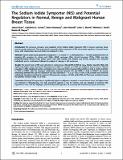| dc.contributor.author | Ryan, James | en |
| dc.contributor.author | Curran, Catherine E. | en |
| dc.contributor.author | Hennessy, Emer | en |
| dc.contributor.author | Newell, John | en |
| dc.contributor.author | Kerin, Michael J. | en |
| dc.contributor.author | Dwyer, Róisín M. | en |
| dc.date.accessioned | 2011-05-25T12:05:14Z | en |
| dc.date.available | 2011-05-25T12:05:14Z | en |
| dc.date.issued | 2011-01 | en |
| dc.identifier.citation | Ryan J, Curran CE, Hennessy E, Newell J, Morris JC, et al. (2011) The Sodium Iodide Symporter (NIS) and Potential Regulators in Normal, Benign and Malignant Human Breast Tissue. PLoS ONE 6(1): e16023. doi:10.1371/journal.pone.0016023 | en |
| dc.identifier.uri | http://hdl.handle.net/10379/1932 | en |
| dc.description.abstract | Introduction: The presence, relevance and regulation of the Sodium Iodide Symporter (NIS) in human mammary tissue remains poorly understood. This study aimed to quantify relative expression of NIS and putative regulators in human breast tissue, with relationships observed further investigated in vitro.
Methods:Human breast tissue specimens (malignant n = 75, normal n = 15, fibroadenoma n = 10) were analysed by RQ-PCR targeting NIS, receptors for retinoic acid (RAR¿, RAR¿), oestrogen (ER¿), thyroid hormones (THR¿, THR¿), and also phosphoinositide-3-kinase (PI3K). Breast cancer cells were treated with Retinoic acid (ATRA), Estradiol and Thyroxine individually and in combination followed by analysis of changes in NIS expression.
Results:The lowest levels of NIS were detected in normal tissue (Mean(SEM) 0.70(0.12) Log10 Relative Quantity (RQ)) with significantly higher levels observed in fibroadenoma (1.69(0.21) Log10RQ, p<0.005) and malignant breast tissue (1.18(0.07) Log10RQ, p<0.05). Significant positive correlations were observed between human NIS and ER¿ (r = 0.22, p<0.05) and RAR¿ (r = 0.29, p<0.005), with the strongest relationship observed between NIS and RAR¿ (r = 0.38, p<0.0001). An inverse relationship between NIS and PI3K expression was also observed (r = ¿0.21, p<0.05). In vitro, ATRA, Estradiol and Thyroxine individually stimulated significant increases in NIS expression (range 6¿16 fold), while ATRA and Thyroxine combined caused the greatest increase (range 16¿26 fold).
Conclusion:Although NIS expression is significantly higher in malignant compared to normal breast tissue, the highest level was detected in fibroadenoma. The data presented supports a role for retinoic acid and estradiol in mammary NIS regulation in vivo, and also highlights potential thyroidal regulation of mammary NIS mediated by thyroid hormones. | en |
| dc.format | application/pdf | en |
| dc.language.iso | en | en |
| dc.rights | Attribution-NonCommercial-NoDerivs 3.0 Ireland | |
| dc.rights.uri | https://creativecommons.org/licenses/by-nc-nd/3.0/ie/ | |
| dc.subject | Surgery | en |
| dc.title | The Sodium Iodide Symporter (NIS) and Potential Regulators in Normal, Benign and Malignant Human Breast Tissue | en |
| dc.type | Article | en |
| dc.local.publishedsource | http://dx.crossref.org/10.1371/journal.pone.0016023 | en |
| dc.description.peer-reviewed | peer-reviewed | en |
| dc.contributor.funder | Cancer Research Ireland | en |
| dc.contributor.funder | HRB | en |
| dc.contributor.funder | National Breast Cancer Research Institute | en |
| nui.item.downloads | 416 | |


